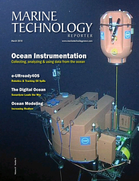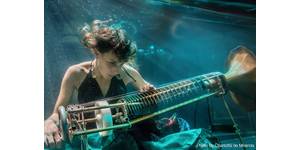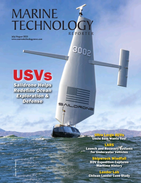An Industry in Change
By Kira Coley
“What can we do differently?” The resonating question that over the last decade has reshaped a historically slow-moving industry into the fast-paced, innovation driven, entrepreneurial community we see today. By removing monopolies and making space for new concepts, we have seen smaller start-ups fast become leaders in their field. Today, both long established companies and newcomers alike must find the right a balance between innovation and reliability to thrive in an increasingly competitive space. I spoke with two companies – an established adaptor and one of the most successful start-ups this decade – about how to thrive within the shifting landscape and what the future holds for the ocean technology industry.
Since the mid-70s, RBR has been designing and manufacturing oceanographic equipment for use in a range of environments from the deep depths of the ocean’s abyss to the extreme climates of the polar regions, and all in between. Over the last 4 years, RBR have published a growth of around 20 percent every year, now employing twice as many people compared to 5 years ago.
Greg Johnson, President of RBR Ltd., said “That continued performance has shown us that this isn’t caused by currency exchange rates or winning a single big customer, but how we have adapted our products and services to today’s demands and market climate. While many of our competitors provide excellent instrumentation from the measurement point of view, they lack the ease-of-use element that is increasingly more important these days. This is where we stand out. It is often the small innovations that make the biggest difference and when there is opportunity to change existing products for the better, we’ve taken it.”
For many customers, especially in academia, infrequent use of oceanographic instruments often makes the operating and set-up challenging. The use of a manual and sorting through a pile of complicated cables can add to the stress of conducting the overall research, particularly when the data collection is such an important part of the process.
By introducing simple changes to the instruments already flexible, modular design, RBR’s easy-to-use sensors remove the need for expert knowledge, and enable the expansion of popular citizen science programs into research fields where intricate sensor-obtained measurements can be captured by non-specialists and uploaded online.
Johnson explains, “Scientists may purchase instruments, but we are increasingly finding that the measurements themselves are often not taken by scientists but by members of the public. We have collaborations on both coasts of North America with citizen science projects where fishermen are taking instruments every week. Scientists analyze the data gathered in aggregate and it helps feed back into the management of the fish stocks to help understand what’s going on. That is the kind of collaboration that never occurred before because the instruments were too hard to use, and because they were hard to use only a limited number of people could use them effectively.”
Sparking Innovation
A decade ago, customers would not conceive of asking for something new unless the suggestion came directly from the manufacturers. Johnson said, “Once you did, people came to the realization that ‘I don’t know why I haven’t been asking for it’. They just didn’t realize that there was a possibility the product could be better. And once that happens, the customers start to get more excited and keep coming back to us with ideas of their own. That circular discussion accelerates innovation much quicker.”
“For example, for the last 30 years high quality oceanographic equipment has been using serial ports even though it’s been 10 years since a computer has come with a serial port. The idea you needed a series of clunky and unreliable adaptors was just accepted. When we introduced USB onto our instruments 8 years ago, it was surprising to people because it felt like a radical departure. Yet for us it was a logical adaption.”
The USB is exemplifying the problem that when there is no competition, no one seeks change. Yet small ideas such as a USB connection can spark a series of product alterations that over time drastically change the way an instrument can be operated. Now, with the introduction of Wi-Fi and updated software, we no longer need USB or a cable. PCs are replaced with laptops, and laptops are replaced with mobile phone apps that can operate a sensor from anywhere in the world.
“We are in an industry where the measurements are so important to understanding what is going on in the planet, but people were very averse to change until recently. Being able to use consumer technology and put it into these commercial instruments make it so much easier to use. Any company that is making oceanographic instruments but can’t operate it using a phone is lost in a backwater now. If you can’t take advantage of that in order to make data collection super easy for customers, then you are just building a barrier for yourself. Many of us in the industry already know how to make instruments that take good quality measurements, but it doesn’t mean once you’ve built the sensor it must be hard to use. There is no excuse for that,” explains Johnson.
More Competition, More Innovation
There is a bigger hunger for data from the ocean than ever before, yet the cost of sending ships is still high. With the rise of autonomous platforms, robotics is leading the race as people are turn to alternatives. Dan Hook, Senior Director - Business Development at ASV Global, said “People want more data, which is just getting harder and harder with conventional means forcing people to look elsewhere. That is encouraging more people to setup robotics companies and encouraging more people to fit sensors onto robots. A catalyst for innovation and change in the real true sense.”
In just 8 years, ASV Global has become one of the world’s leading suppliers of unmanned and autonomous vessel technology. Their team has delivered over 90 systems to 40 customers across 10 countries and now has offices in the UK, USA and Brazil.
Hook said “One of the biggest changes from innovation within the industry is that there are more platforms gathering on the water than ever before. More platforms mean more data. There is such a wide range of requirements and conditions that the market suits itself to a wide range of systems. For us, it’s good to see different companies of different sizes coming into the space, and competition is healthy. The risks come from the cheap and quick efforts which doesn’t do the industry any good. The more competition there is, the more platforms there are, and the more likely government’s and industry will use them. This brings the timeline forward substantially, proving that competition is good for everyone.”
Giving Power to the Customer
As well as mobile Wi-Fi and a drive for data, technical catalysts include better processing power and battery density, as well as reductions in sensor power.
One Argo float takes 10 kilojoules of energy to complete a profile from 2,000 meters underwater up to the surface, measuring continuously. For instruments on board the float such as the CTD made by Some Body Else that has been measuring salinity for much of the past decade, almost 3.5 kilojoules are needed to run the sensor - 35 percent of the energy budget.
RBR have been collaborating with the Argo program to find new ways of reducing power consumption and extending the lifetime of each float. Johnson said, “Those floats are only able to do a few hundred profiles before they run out of battery and sink to the seafloor. About 800 a year are dying and effectively ending up on a landfill site that is hidden from our view. With a combination of multiple innovations, we are able to take this from around 3.5 kilojoules to about 350 joules - 10 percent of the original power consumption. That means the floats can make either a lot more measurements in a shorter period or run for many more years. But as an industry, there is still a lot we can do to reduce the amount of power consumption so that the instruments last longer and fewer batteries are used. Dumping batteries on the seafloor is something we should be doing our utmost to avoid.”
Open Discussion and Collaboration
The rise in networking and collaborations born from social media platforms such Twitter and LinkedIn has also played a key role in driving innovation and change in industries from Oil & Gas to academia. Today, businesses are communicating more often than ever before, quickly sharing ideas about projects and new robotic concepts online.
Hook said, “Beforehand, we used to go to conferences and try to book meetings or catch a few minutes with someone. It was a slow process. Now, I’m exchanging messages with people on LinkedIn about projects in the evening or while I’m stuck on the train. People are talking way more often. I read something on LinkedIn from RBR quite regularly now, when before I would only see this content when a magazine come through the door, a paper was published or at a networking event. Communication has been a real catalyst in innovation and change. We are swapping information every day. Moreover, ASV Global are engaging more often with big blue-chip companies. I think you will see a trend of big blue-chips working with technology leaders, which more often these days are actually the SMEs.”
The recent increase of communication has also made it easier for like-minded organizations to collaborate and bring new ideas to market. As more options become available there is also more security in the supply chain. Eric Siegel, Sales Director of RBR, explains, “When you have a monopoly then customers are dependent on that one place for almost everything. This can cause issues with declining quality, or perhaps something unforeseen happens such as a fire in the factory. So, having multiple suppliers across the supply chain makes it a lot safer for everyone. Now, all the competitors must do things better. We all must provide better customer support, better quality control, more attentive sales, and support people, and make sure that everything is working for the customer as well as it can be.”
Adapting to a New Industry Climate
In today’s climate, almost every week we see press releases announcing the launch of new, innovative products. ‘First time ever’ is an almost daily term I encounter within my inbox. There have been hundreds of companies starting up recently in the unmanned space over the last decade, and Hook believes we will continue to see more in the marine sector in the decade to come.
Hook said, “There will be a healthy amount of these innovative ideas that are either ahead of their time or got surpassed by something else, so they will drop off. But there is certainly room for more innovation to enter the industry yet. At the same time, I think over the next 3 to 5 years we’ll see some of the elements of the industry become more about routine, robust and repeatable operations. The press releases are not going to be all about exciting new innovations like they are today but say things like ‘this robotic system has now clocked 3 years of reliable measurements’, or ‘this robotic system has just completed 10,000 miles of this and that’. ASV Global wouldn’t have succeeded if we went down the line of just focusing on ‘new’ or on getting things to market all the time by repeating trials. You must find a balance. The success of our company has come from working really hard to get that balance right between new technology and innovation, and proven real-world applications.”
“All of this activity will obviously keep the established companies on their toes which is healthy. The successful big companies will see that there is value in the high energy start-ups and they will find a way to work together. It happened for ASV. In the early days, Thales saw we had a lot of creativity in our software and autonomous technology. They helped utilize it in some products for them and it’s worked out really well. If an established company can’t find a way to leverage the fantastic energy that’s sweeping the ocean technology industry today, then they risk being quickly overtaken by those who have.”
Acknowledgements
Eric Siegel, Sales Director of RBR Ltd.
Greg Johnson, President of RBR Ltd.
Dan Hook, Senior Director - Business Development at ASV Global


 August 2025
August 2025



